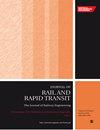Track and catenary reconstruction from aerial images for the realistic analysis of rail electrification systems
IF 2.1
4区 工程技术
Q3 ENGINEERING, CIVIL
Proceedings of the Institution of Mechanical Engineers Part F-Journal of Rail and Rapid Transit
Pub Date : 2023-06-28
DOI:10.1177/09544097231185800
引用次数: 0
Abstract
Currently, the modelling of the railway catenaries for straight tracks is well understood and demonstrated via an accepted number of applications and an international benchmark. However, in the presence of a general track geometry, including curved tracks, challenges still remain. The fundamental difficulty is how to address the catenary layout in the presence of curves for a long railway track in which a large number of catenary sections are defined. To support the catenary design, e.g. in new electrification projects, it is fundamental to identify the track geometry, which is not always accessible to the overhead line engineers. This work purposes a novel approach for track geometry reconstruction using aerial views. The reconstruction methodology is based on the general geometry rules for track design. The track geometry obtained is then used as the reference to define the layout of the catenary. The Network Rail Series 1 overhead equipment is used here and the 3D finite element model of the catenary is built on the curved track geometry. The results of this work demonstrate, not only the advances proposed to study more realistically the pantograph-catenary interaction, but also the need to consider general curved tracks in acceptance and interoperability studies.基于航拍图像的轨道和悬链线重建,用于铁路电气化系统的现实分析
目前,直线轨道的铁路悬架的建模已经得到了很好的理解,并通过一些公认的应用程序和国际基准进行了演示。然而,在一般轨道几何形状(包括弯曲轨道)存在的情况下,挑战仍然存在。对于具有大量接触网段的长轨道,如何解决存在曲线时的接触网布置问题是最根本的困难。为了支持悬链线设计,例如在新的电气化项目中,确定轨道几何形状是至关重要的,而架空线路工程师并不总是能够获得这些几何形状。这项工作的目的是利用鸟瞰图重建轨道几何形状的新方法。重建方法是基于轨道设计的一般几何规则。然后将得到的轨迹几何形状作为参考来定义悬链线的布局。本文采用Network Rail Series 1架空设备,在曲线轨道几何上建立接触网的三维有限元模型。这项工作的结果不仅表明了更现实地研究受电弓-接触网相互作用的进展,而且表明了在接受和互操作性研究中考虑一般弯曲轨道的必要性。
本文章由计算机程序翻译,如有差异,请以英文原文为准。
求助全文
约1分钟内获得全文
求助全文
来源期刊

CiteScore
4.80
自引率
10.00%
发文量
91
审稿时长
7 months
期刊介绍:
The Journal of Rail and Rapid Transit is devoted to engineering in its widest interpretation applicable to rail and rapid transit. The Journal aims to promote sharing of technical knowledge, ideas and experience between engineers and researchers working in the railway field.
 求助内容:
求助内容: 应助结果提醒方式:
应助结果提醒方式:


